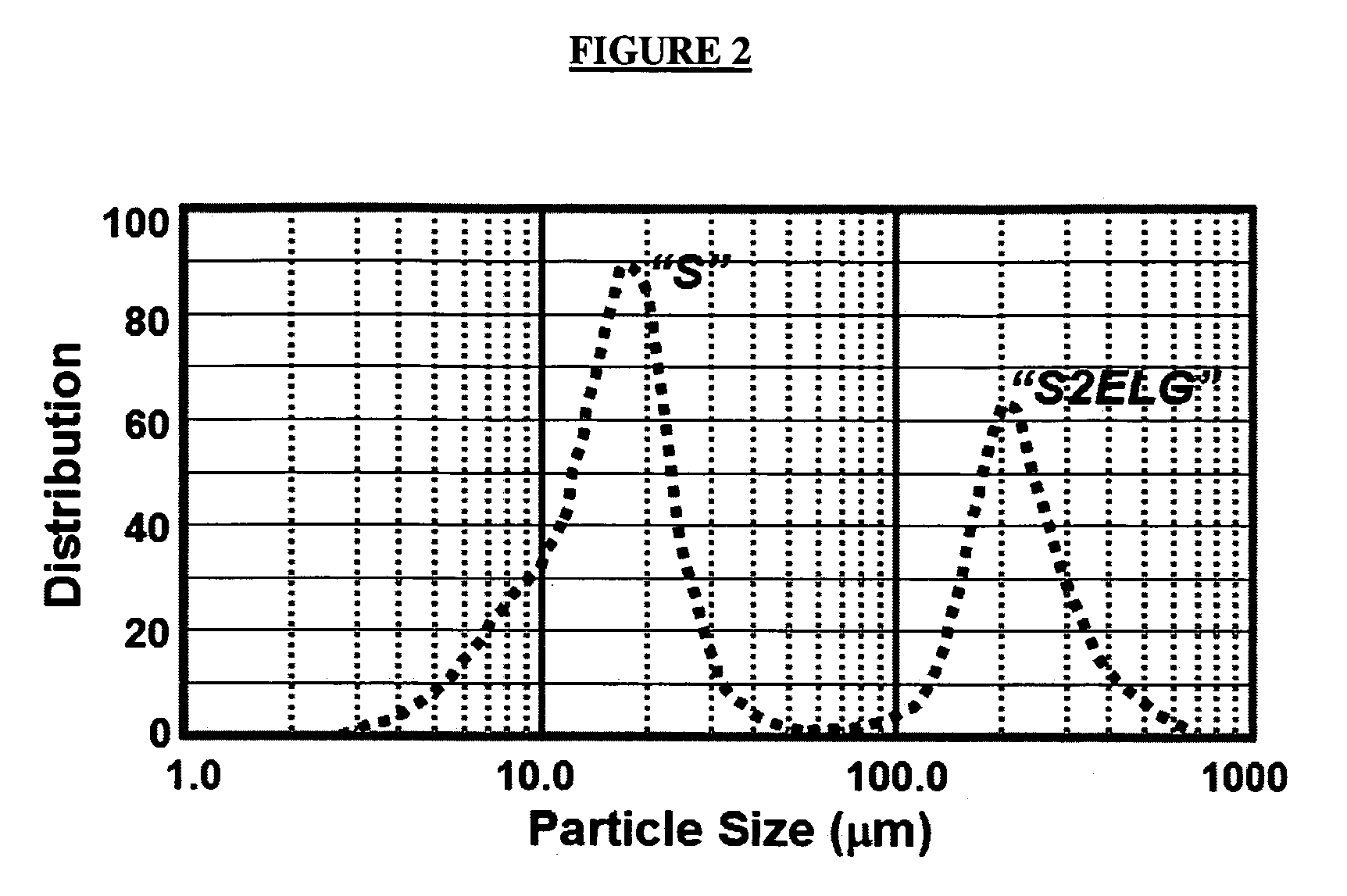Bimodal and multimodal dense boride cermets with superior erosion performance
- Summary
- Abstract
- Description
- Claims
- Application Information
AI Technical Summary
Benefits of technology
Problems solved by technology
Method used
Image
Examples
example 1
Illustrative Example 1
Bimodal TiB2 Cermet Composition with H. C. Starck's TiB2 Grit and Stainless Steel Metal Binder
[0051] As a non-limiting example, 33 vol % coarse TiB2 grit (S2ELG), 33 vol % of fine TiB2 grit (S), and 34 vol % Ti-modified 304 stainless steel (304SS+0.25Ti) were mixed in a ball mill in the presence of heptane for a time sufficient to substantially disperse the powders in each other. The TiB2 powder has a bimodal distribution of particles in the size range 3 to 60 microns and 61 to 800 microns. The mixture of powders was milled in a ball mill for about 4 hours. Paraffin wax was also added to the ball mill to provide green strength to the compact after the pressing step. The amount of paraffin wax added was about 2 to 4 wt % of the combined weight of both TiB2 grit and stainless steel binder. After milling process, the liquid was removed and the milled powder was dried. The amount of milling media in the ball milling process was less than 40% of the powder added. Y...
example 2
Illustrative Example 2
Bimodal TiB2 Cermet Composition with Sintec-Keramik's TiB7 Grit and Stainless Steel Metal Binder
[0054] Table 3 depicts exemplary coarse and fine TiB2 grits and a metal binder used for producing bimodal boride cermets having a high packing density. The bimodal premix powder supplied from Sintec-Keramik (Development product, Lot PWT2S1-1963) is further screened to separate both fine and coarse grits.
TABLE 3CompanyGradeChemistry (wt %)SizeSintec-FineTi: Balance, B: 30.2%, C: 0.02%, O: 0.2%,−53 μmKeramikN: 0.2%, Ca: 0.05% (Sieved from the Lot(below 270 mesh)PWT2S1-1963)Sintec-CoarseTi: Balance, B: 30.2%, C: 0.02%, O: 0.2%,+106-800 μmKeramikN: 0.2%, Ca: 0.05% (Sieved from the Lot(above 140 mesh)PWT2S1-1963)Carpenter321SSBalance85% −31 μmPowderFe: 18.0Cr: 10.0Ni: 1.2Ti: 1.4Mn: 0.2SiProducts
[0055] Table 4 depicts the particle size distribution of Sintec-Keramik's coarse TiB2 grit used for producing closely packed TiB2 cermet of the instant invention.
TABLE 4Approx...
example 3
Illustrative Example 3
Bimodal TiB2 Cermet Composition with ESK-Ceradyne's TiB2 Grit and Stainless Steel Metal Binder
[0065] Table 6 depicts exemplary coarse and fine TiB2 grits and a metal binder used for producing bimodal boride cermets having a high packing density.
TABLE 6CompanyGradeChemistry (wt %)SizeESK-411M20Ti: Balance, B: 29.3%, C: 0.73%, O:Ds3 = 44.4 μmCeradyne(Fine)0.87%, N: 0.17%, Fe: 0.10%Ds50 = 17.4 μmDs94 = 3.5 μmESK-408M3Ti: Balance, B: 29.5%, C: 1.11%, O:99.9% −1000 μmCeradyne(Coarse)0.61%, N: 0.18%, Fe: 0.16%Carpenter321SSBalance85% −31 μmPowderFe: 18.0Cr: 10.0Ni: 1.2Ti: 1.4Mn: 0.2SiProducts
[0066] Table 7 depicts the particle size distribution of ESK-Ceradyne's coarse TiB2 grit (Grade 408M3) used for producing closely packed TiB2 cermet in this invention. Fine grits screened below 200 mesh (75 μm) were discarded.
TABLE 7ApproximateVolumeTiB2 Mesh SizeMicron Size (μm)Fraction (%)+45+35525.9+60 / −45+250 / −35517.1+140 / −60 +106 / −25031.0+200 / −140 +75 / −10616.0Total100
[0...
PUM
| Property | Measurement | Unit |
|---|---|---|
| Temperature | aaaaa | aaaaa |
| Temperature | aaaaa | aaaaa |
| Temperature | aaaaa | aaaaa |
Abstract
Description
Claims
Application Information
 Login to View More
Login to View More - R&D Engineer
- R&D Manager
- IP Professional
- Industry Leading Data Capabilities
- Powerful AI technology
- Patent DNA Extraction
Browse by: Latest US Patents, China's latest patents, Technical Efficacy Thesaurus, Application Domain, Technology Topic, Popular Technical Reports.
© 2024 PatSnap. All rights reserved.Legal|Privacy policy|Modern Slavery Act Transparency Statement|Sitemap|About US| Contact US: help@patsnap.com










